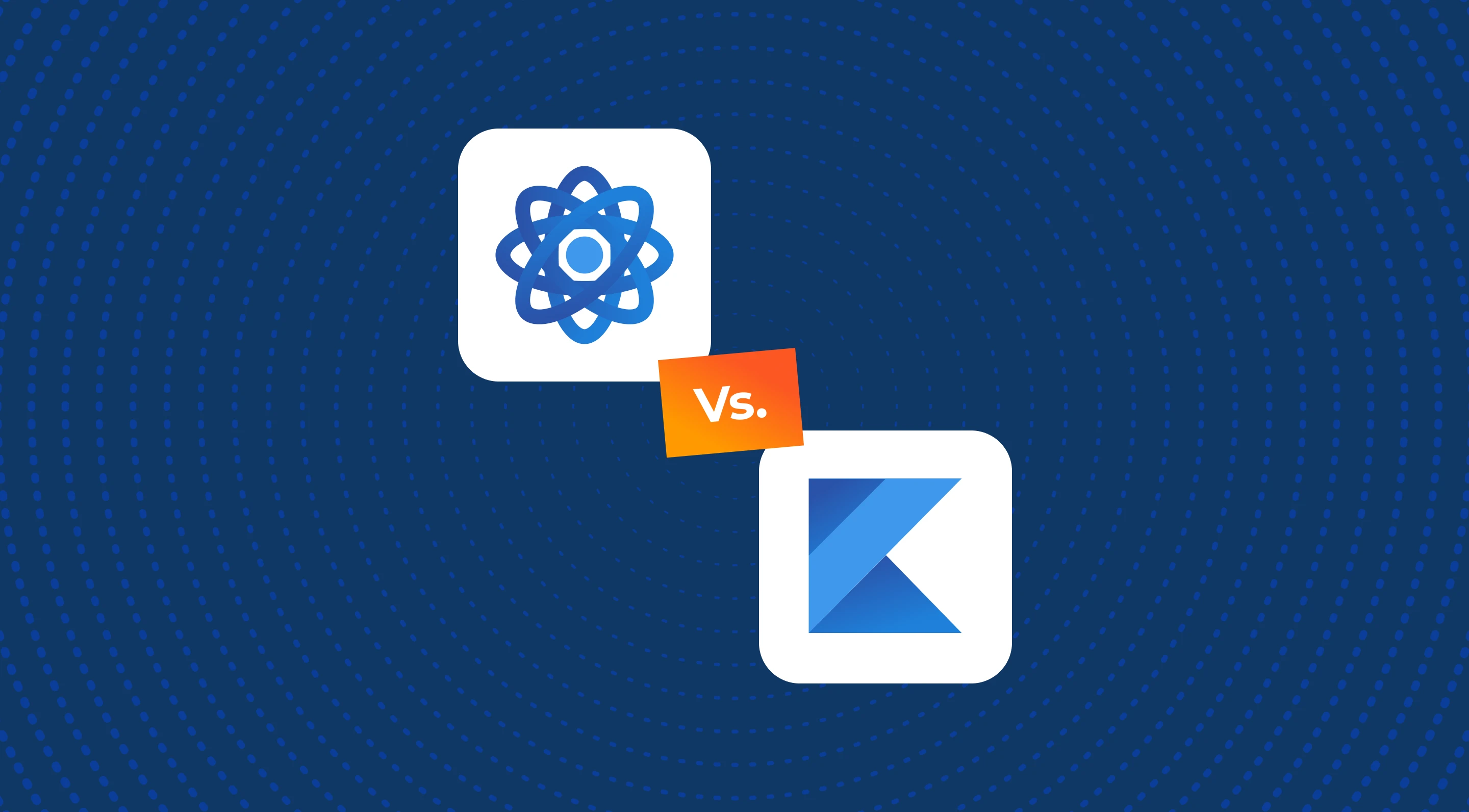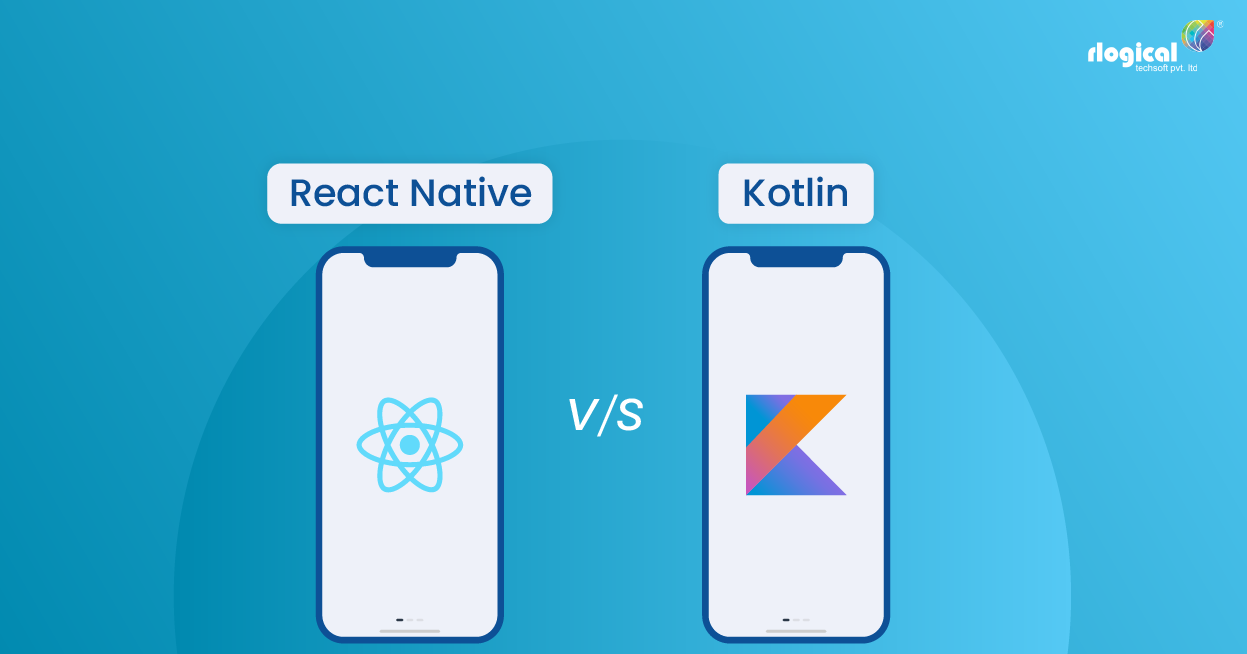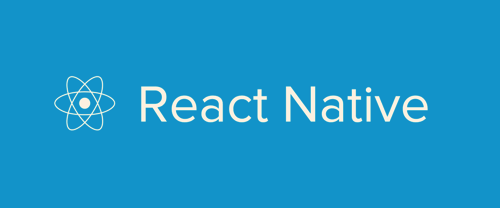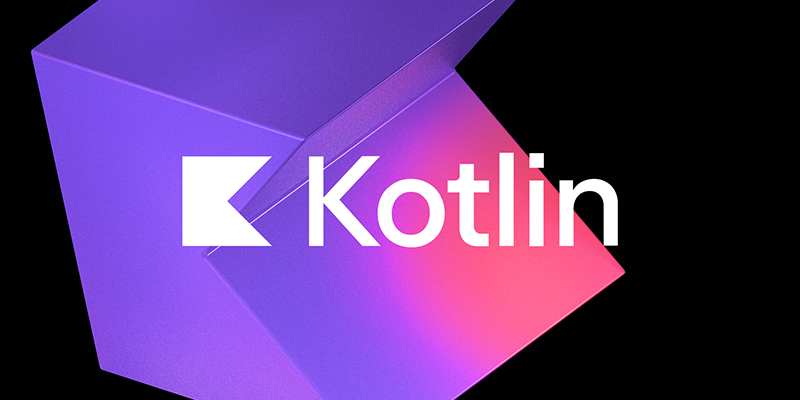SHARE
An Overview of React Native vs. Kotlin

Contents
Contents
Mobile application development has grown into a mega industry over the past decade. The debate over the best mobile technology continues as more companies adopt cross-platform frameworks to create mobile apps to grow their businesses. Today we compare React Native vs. Kotlin.
As of 2022, the total revenue in the mobile app market is projected to rise to US $430.90 billion. The annual growth rate is expected to be at 9.27%, which means by 2026, the market volume will be at US $614.40 billion.
Most mobile application developers target Android users, who comprise 70.96% of mobile technology consumers. Therefore, numerous frameworks and programming languages, such as React Native and Kotlin, enable companies to reach their goals and objectives.

What is Kotlin?
Kotlin is a common cross-platform, statically-typed programming language released in 2011 by JetBrains. The open-source framework is interoperable with Java and common among Android developers.
Kotlin gained popularity after Google’s endorsement as the official Android Studio language. It provides support to multiple IDEs and tools.
Kotlin Multiplatform Mobile (KMM) has caught the attention of developers in that it is an excellent SDK for Android and iOS mobile App development. Giant organizations such as Netflix, Philips, and VNWare trust KMM.
What is React Native?
React Native is a Facebook creation developed in 2015 as a cross-platform open-source mobile app framework. React Native makes use of the JavaScript programming language when developing native Android, iOS, web, and UWP apps. Primarily React Native is used to create cross-platform mobile apps for iOS and Android.
World-leading tech companies such as Facebook, Uber, Airbnb, Microsoft, Pinterest, and Bloomberg, among others, use React Native.
Wondering which of the two frameworks will help meet your organizational goal? Keep reading to find out!
Benefits of React Native Over Kotlin
According to Statistics, React Native remains more popular among Android Mobile App developers, which means that it has more benefits compared to Kotlin. Let’s look at the benefits of React Native over Kotlin.

JavaScript is more popular than Kotlin
JavaScript, the language React Native is written in, is the most popular programming language, period. This means there are more developers that know JavaScript, more development resources, and a large community of support.
React Native Saves Time Compared to Kotlin
When you are building a cross-platform mobile app, React Native will be faster than Kotlin. This is simply because with React Native you can build for both iOS and Android with one codebase. If you are building an app for iOS and Android but you are using Kotlin, that means you have a separate codebase for Android and another one for iOS.
While it may be a misconception that React Native cuts development time in half, it certainly does save a good ordeal of time compared to writing the same piece of software twice, once for iOS and once for Android.
React Native Saves Money Compared to Kotlin
When you are building a cross-platform mobile app, there are a few reasons why React Native is more cost-effective than Kotlin. First, there is the fact that your development efforts are more concentrated. All of your engineers can focus on one codebase in order to get your app to the app stores.
A complicating factor with native technologies is that they are very different. Swift, the official programming language of iOS, and Kotlin, the official programming language of Android, are not very similar to each other. This can often mean that you have an added expense of hiring people that specialize in each. With React Native, you can reduce your development overhead and have your team focus simply on JavaScript.
React Native is a Cross-Platform
Yes, the biggest advantage React Native has over Kotlin is that React Native is cross-platform, so one codebase can be written when developing an app for both iOS and Android. When you utilize Kotlin, you must create a separate codebase for iOS apps from the one you have for Android. For many businesses, this is the dealbreaker when comparing React Native vs. Kotlin.
React Native has Better Hot Reloading Support
One of the benefits of React Native is that it can take advantage of the wealth of JavaScript tooling available. In the case of developing user interfaces, having stable hot reloading is a huge advantage. Hot reloading allows you to make changes in code and see them reflected in your app without reloading the app. Without hot reloading, you have to open your app from scratch and manually navigate to the screen you are building in order to see code changes. This is extremely tedious if you are a front-end developer. Because JavaScript powers the web, stable hot reloading was accomplished within the programming language quite a long time ago. In contrast, native technologies are still ironing out issues related to hot reloading.
React Native is More Approachable
Because React Native is written in JavaScript, it is more approachable than Kotlin. The fact is, there’s really no reason to learn Kotlin unless you’re doing Android development. JavaScript on the other hand is used almost everywhere, and most engineers interact with it in some fashion. Because of the ubiquity of JavaScript, React Native is easier for web developers or other developers that are knowledgeable of JavaScript to get started with.
React Native has More Third-Party Libraries
Due to the size of the JavaScript community, it is hard to compete with many of the development resources available to it. This is true of third-party libraries. While React Native cannot necessarily use every library built for web applications, it can use a ton of JavaScript libraries. Testing libraries, HTTP request libraries, state management libraries, and code formatting libraries are just a few of the common web development areas that React Native apps commonly pull from.
React Native has a Smaller Learning Curve
If you are new to mobile software development, React Native has a smaller learning curve than utilizing Kotlin for Android app development. This is simply because most engineers will have a foundation in JavaScript, and perhaps even React. This means that a lot of engineers focus most of their time on learning React Native as opposed to a programming language. When you start doing native app development using Kotlin, you are almost guaranteed to have to learn not only Android development but also Kotlin programming language.
Benefits of Kotlin Over React Native
That’s enough of React Native. Let’s take a look at some of the benefits that Kotlin has to offer over React Native.

Kotlin has a Better Performance
React Native has near-native performance. But, Kotlin has actual native performance. It would be very difficult for a framework like React Native to achieve the performance of a native technology like Kotlin. One of the biggest performance issues with React Native has to do with the “React Native Bridge.” In React Native, there exists a “bridge” over which JavaScript code communicates with native UI components. Serialized JSON data is passed back and forth over the bridge between JavaScript and native code. Today, the bridge in React Native is the largest hindrance to performance. However, the React Native team is working on Fabric, a new rendering system that eliminates the bridging concept and should bring superior performance to React Native.
Kotlin is Statically Typed
Static typing is a nice programming language feature that ensures that the right types are used for data structures within applications. This reduces the possibility of type-related errors in a live application. Additionally, static typing provides nice development benefits.
React Native does support TypeScript, which adds type-checking on top of JavaScript. However, this feature is not built into JavaScript, and you cannot rely on the fact that different libraries utilize it.
Kotlin Supports More Android Devices
Naturally, as the official programming language of Android, Kotlin has better support for Android devices. Whereas React Native is targeted toward Android phones and tablets, Kotlin will allow you to expand into many other categories of Android devices.
Which one is Better: React Native or Kotlin?
Choosing React Native vs. Kotlin will depend on the nature of the project at hand. React Native enables enterprises to build iOS and Android applications using one codebase. In most cases, performance is not a concern for React Native and a lot of companies can take advantage of it as a solution for cross-platform apps. React Native is, therefore, still considered the first choice when developing cross-platform applications.
Each option has its pros, allowing enterprises to make decisions based on their goals.
Kotlin vs. React Native: Final Thoughts
Choosing the right technology can be daunting for enterprises, given the numerous factors to consider. React Native and Kotlin are both open source and readily available, making the decision harder. Additionally, they are equally as popular as each other, leaving no clearly leading winner in the comparison.
In many situations, the decision between React Native vs. Kotlin simply comes down to whether or not cross-platform app development is a priority and feasible for your business. If you are building Android apps that need no iOS counterpart, or if cross-platform solutions are not feasible due to the nature of your business, then Kotlin will make more sense for your Android needs.
Flatirons has the best team of React Native developers. We will work with your team from start to finish during the entire development of your preferred app. Your win is our win.
React Native Development Experts
Flatirons provides React Native development services tailored for your business needs.
Get the CEO's Take
Handpicked tech insights and trends from our CEO.
React Native Development Experts
Flatirons provides React Native development services tailored for your business needs.
Get the CEO's Take
Handpicked tech insights and trends from our CEO.

Perl vs Python: Choosing the Right Scripting Language
Flatirons
Apr 20, 2025
IoT Database: Manage Connected Device Data Efficiently
Flatirons
Apr 14, 2025
Proof of Concept Template: A Step-by-Step Guide
Flatirons
Mar 26, 2025
Objective C vs Swift: Which is Better for iOS App Development?
Flatirons
Mar 25, 2025
Scala vs Kotlin: Comparing the Functional Programming Giants
Flatirons
Mar 22, 2025
IoT Smart City Solutions: Transforming Urban Living
Flatirons
Mar 17, 2025